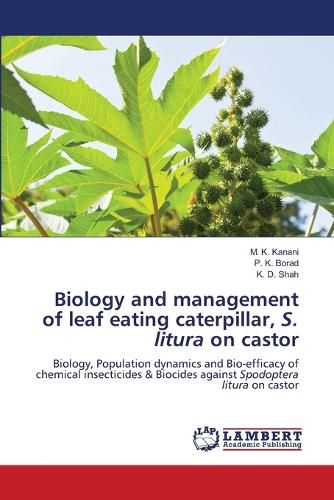Readings Newsletter
Become a Readings Member to make your shopping experience even easier.
Sign in or sign up for free!
You’re not far away from qualifying for FREE standard shipping within Australia
You’ve qualified for FREE standard shipping within Australia
The cart is loading…






This title is printed to order. This book may have been self-published. If so, we cannot guarantee the quality of the content. In the main most books will have gone through the editing process however some may not. We therefore suggest that you be aware of this before ordering this book. If in doubt check either the author or publisher’s details as we are unable to accept any returns unless they are faulty. Please contact us if you have any questions.
Castor (Ricinus communis L.) belongs to family Euphorbiaceae is one of the most important and valuable non-edible in oilseed group. It can be grown under varying soil types and erratic nature of monsoon due to its drought tolerance habit. Of the nine biocides evaluated against S. litura infesting castor, Spodoptera litura Nuclear Polyhedrosis Virus @ 250 LE/ha, Beauveria bassiana (0.4%) were effectively manage the incidence of S. litura on castor. These two biocides produced higher (26.77 to 28.33 q /ha) yield of castor. In the above treatments, yield increase over control ranged from 81.30 to 91.88 per cent, whereas avoidable losses were up to 7.18 per cent. The NICBR was noted 1:35.38 and 1:24.01 in effective biocides of Spodoptera litura Nuclear Polyhedrosis Virus @ 250 LE/ ha and Beauveria bassiana @ 0.4 %, respectively. Among the nine synthetic insecticides tested against S. litura on castor, chlorantraniliprole 20 SC @ 0.006% and emamectin benzoate 5 WG @ 0.002% performed better to protect the castor crop. These two insecticides produced higher (31.10 to 31.83 q /ha) yield of castor. In the above treatments, yield increase over control ranged from 21.24 to 90.48 per cent.
$9.00 standard shipping within Australia
FREE standard shipping within Australia for orders over $100.00
Express & International shipping calculated at checkout
Stock availability can be subject to change without notice. We recommend calling the shop or contacting our online team to check availability of low stock items. Please see our Shopping Online page for more details.
This title is printed to order. This book may have been self-published. If so, we cannot guarantee the quality of the content. In the main most books will have gone through the editing process however some may not. We therefore suggest that you be aware of this before ordering this book. If in doubt check either the author or publisher’s details as we are unable to accept any returns unless they are faulty. Please contact us if you have any questions.
Castor (Ricinus communis L.) belongs to family Euphorbiaceae is one of the most important and valuable non-edible in oilseed group. It can be grown under varying soil types and erratic nature of monsoon due to its drought tolerance habit. Of the nine biocides evaluated against S. litura infesting castor, Spodoptera litura Nuclear Polyhedrosis Virus @ 250 LE/ha, Beauveria bassiana (0.4%) were effectively manage the incidence of S. litura on castor. These two biocides produced higher (26.77 to 28.33 q /ha) yield of castor. In the above treatments, yield increase over control ranged from 81.30 to 91.88 per cent, whereas avoidable losses were up to 7.18 per cent. The NICBR was noted 1:35.38 and 1:24.01 in effective biocides of Spodoptera litura Nuclear Polyhedrosis Virus @ 250 LE/ ha and Beauveria bassiana @ 0.4 %, respectively. Among the nine synthetic insecticides tested against S. litura on castor, chlorantraniliprole 20 SC @ 0.006% and emamectin benzoate 5 WG @ 0.002% performed better to protect the castor crop. These two insecticides produced higher (31.10 to 31.83 q /ha) yield of castor. In the above treatments, yield increase over control ranged from 21.24 to 90.48 per cent.